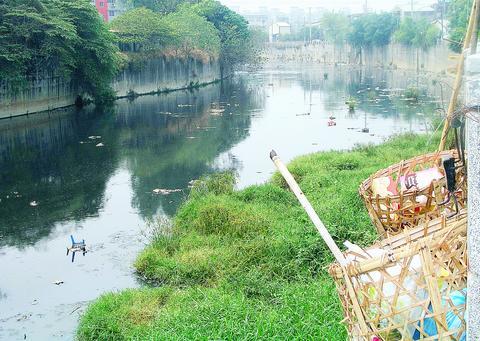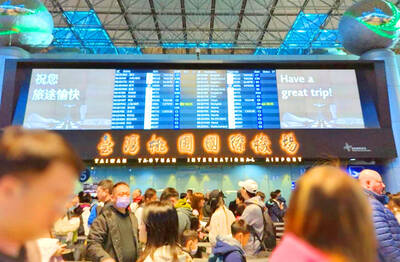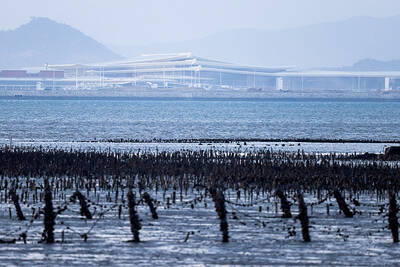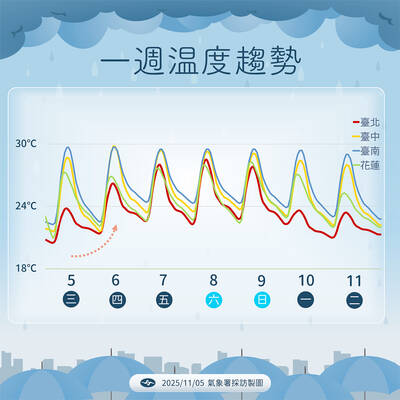Illegal leather tanning factories along Fengshan River (
EPA Administrator Chang Juu-en (

PHOTO: CHAI CHING-HUA, TAIPEI TIMES
At the ceremony, also attended by Kaohsiung County Commissioner Yang Chiu-hsing (楊秋興), Fengshan Mayor Lin San-lang (林三郎), and Chinese Nationalist Party (KMT) Legislator Lin Yi-shih (林益世), clear water was poured into the river to symbolize the river's future vitality.
"Staff of environmental agencies at all levels will inspect illegal tanning factories in order to revive the Fengshan River," Chang said.
Originating in the mountainous areas of Kaohsiung County, the river passes through Fengshan City, population 300,000, before entering neighboring Kaohsiung City.
The commissioner said that three or four decades ago, when its water was still clean, the river was a popular place for swimmers. However, now it is notorious for being heavily polluted by household sewage and industrial wastewater.
"To make the river accessible, restoration projects will include planting trees, paving paths for recreational walkers, and building sewer systems," Yang said.
In the county, a sewage treatment plant will be completed by April next year to intercept polluted waters.
EPA officials said that for decades the waters of the 20km Fengshan River have been polluted by waste water from illegal leather tanning factories.
Since 2002, the river has been listed as one of the nation's 13 most seriously polluted rivers ranked as deserving comprehensive treatment.
According to Leu Horng-guang (
As a result, three registered factories were penalized for discharging untreated wastewater, four illegal tanning factories were shut down, and two illegal wells used by tanning factories were closed.
After visiting the river yesterday, Leu said that treating the river was urgent.
"The river water I observed under the scorching sun in the south was even bubbling," Leu told the Taipei Times.
According to Leu, in 2004 and 2005 the EPA will allocate the local authority about NT$400 million to carry out restoration work along a 5km section of the river near Fengshan City.
The first stage of this work will be completed by the end of next year.
Downstream, the river crosses the border into Kaohsiung City and runs through the industrial zones of the city. It was once so heavily polluted that no fish could survive in it.
Several years ago, however, the Kaohsiung City government built a sewer system to intercept the polluted water. Currently, about 300,000 metric tons of polluted river water are diverted to a municipal sewage treatment plant daily.

Three Taiwanese airlines have prohibited passengers from packing Bluetooth earbuds and their charger cases in checked luggage. EVA Air and Uni Air said that Bluetooth earbuds and charger cases are categorized as portable electronic devices, which should be switched off if they are placed in checked luggage based on international aviation safety regulations. They must not be in standby or sleep mode. However, as charging would continue when earbuds are placed in the charger cases, which would contravene international aviation regulations, their cases must be carried as hand luggage, they said. Tigerair Taiwan said that earbud charger cases are equipped

Foreign travelers entering Taiwan on a short layover via Taiwan Taoyuan International Airport are receiving NT$600 gift vouchers from yesterday, the Tourism Administration said, adding that it hopes the incentive would boost tourism consumption at the airport. The program, which allows travelers holding non-Taiwan passports who enter the country during a layover of up to 24 hours to claim a voucher, aims to promote attractions at the airport, the agency said in a statement on Friday. To participate, travelers must sign up on the campaign Web site, the agency said. They can then present their passport and boarding pass for their connecting international

UNILATERAL MOVES: Officials have raised concerns that Beijing could try to exert economic control over Kinmen in a key development plan next year The Civil Aviation Administration (CAA) yesterday said that China has so far failed to provide any information about a new airport expected to open next year that is less than 10km from a Taiwanese airport, raising flight safety concerns. Xiamen Xiangan International Airport is only about 3km at its closest point from the islands in Kinmen County — the scene of on-off fighting during the Cold War — and construction work can be seen and heard clearly from the Taiwan side. In a written statement sent to Reuters, the CAA said that airports close to each other need detailed advanced

UNKNOWN TRAJECTORY: The storm could move in four possible directions, with the fourth option considered the most threatening to Taiwan, meteorologist Lin De-en said A soon-to-be-formed tropical storm east of the Philippines could begin affecting Taiwan on Wednesday next week, the Central Weather Administration (CWA) said yesterday. The storm, to be named Fung-wong (鳳凰), is forecast to approach Taiwan on Tuesday next week and could begin affecting the weather in Taiwan on Wednesday, CWA forecaster Huang En-hung (黃恩鴻) said, adding that its impact might be amplified by the combined effect with the northeast monsoon. As of 2pm yesterday, the system’s center was 2,800km southeast of Oluanbi (鵝鑾鼻). It was moving northwest at 18kph. Meteorologist Lin De-en (林得恩) on Facebook yesterday wrote that the would-be storm is surrounded by